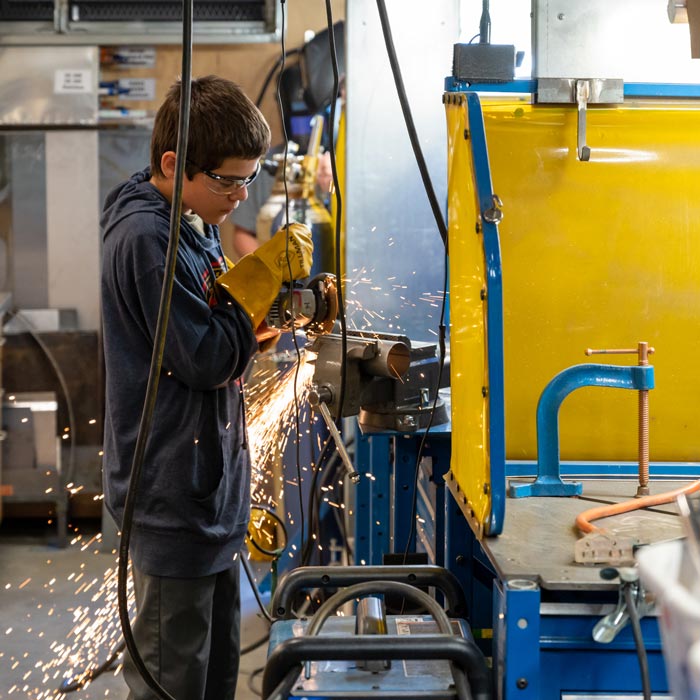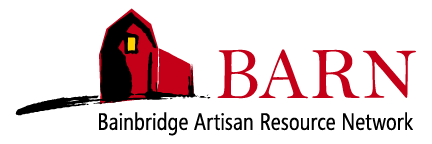FAQ
Metal Fabrication Studio Policies
That’s a big question. The answer depends on the shop in which you want to begin.
- For the Machine Shop, begin with Orientation and the basic Make a Bolt (Intro to the Lathe) and Make a Nut (Intro to the Vertical Mill).
- For the combined Welding, Plasma Cutting, and Sheet Metal shop, JAWS Orientation is recommended.
- To go straight into Sheet Metal, begin with Intro to Sheet Metal.
- For Welding, begin with Wacky-Tacky Art… it’s an all-around intro to the tools with hands-on experience.
- For Casting and Foundry Arts, we have some easy-access online classes that provide an excellent overview. But to get your hands dirty, start with Make a
- Pattern. Then use that pattern in a Casting class to make a mold and make a casting. Finally, to complete your casting, take the Finishing class to smooth any casing imperfections and apply a warm patina.
- For Forge and Blacksmithing, simply sign up for a class. All the necessary safety equipment will be supplied, but feel free to bring your own.
To attend Open Studio, take any required prerequisite classes (generally the introductory class for that particular discipline) and register using our catalog.
Due to the potentially dangerous equipment in the Metal Fabrication Studio, only studio leads, monitors, and teachers have fob access.
Open Studio events vary with each shop.
- Machine shop has 2-3 Open Studio events per week.
- The Welding and Sheet Metal shop has 1-2 events per week.
- Casting and Foundry has one event per month, although that can expand with demand.
- The Forge and Blacksmithing program currently has no Open Student events. As that program develops, Open Studio events will be added.
Most definitely. All of these requirements are covered during Orientation and Introduction events.
Skills cards are used to register skills attained. However, competency must be demonstrated to use the equipment.
The short answer is: Sometimes. We do loan hand tools for short periods of time. Power hand tools are loaned on a case-by-case basis. We do not loan any tool that can’t be held in one hand.
Drop by the shop of interest and engage the shop manager. Or contact the Studio Lead at metal.lead@bainbridgerbarn.org.
Machining
There’s usually some kind of activity happening in the Machine Shop, so please do drop in and check it out. The best way to build skills is by doing, but you need to have a foundation of understanding before you set off on your own. The first step is Orientation, then start with the following:
- One- and two-session classes 2-3 hours in duration that offer both foundational understanding and hands-on experience.
- Custom Classes where a skilled instructor guides the student through a special project showing the way toward project completion.
- Opportunities to clean and maintain the machines and spaces is an excellent way to learn your way around machine tools, but also helps keep the shop ship-shape.
- With increased skill, individuals can serve as monitors during open studio events to gain additional experience and expand their abilities.
Welding & Plasma Cutting
Take one of our beginner welding classes! The welding studio offers a progression of classes in both MIG and TIG. These are taught by a range of professional and amateur welders to begin and advance your skill level. BARN’s classes are generally focused on hobby and art welding.
Knowing there’s no substitute for “hood time” to enhance your skills, we hold open studio events to work on projects or practice to further your competency.
We also offer special classes and workshops. Over time these have included oxy/acetylene (gas) sculpture welding, garden art from found objects, designing and creating a table, creative reuse of tableware, display stands, garden art, gates and trellises, as well as aluminum welding techniques in both MIG and TIG.
Yes! We focus on two primary welding processes: MIG and TIG. MIG (Metal Inert Gas) welding is the easiest to learn and the most versatile. It has wide application from garden art to furniture to structural.
TIG (Tungsten Inert Gas) welding is a bit more challenging, requiring good hand-eye coordination and a delicate touch, but produces beautiful welds with a more finished look. Both MIG and TIG are applicable to aluminum and steel.
BARN offers a progression of classes in both methods taught by a range of professional and amateur metal workers. As with most skills, there’s no substitute for practice. In recognition of that, the Welding and Sheet Metal Studio hosts open studio events so folks may practice and develop their plasma cutting skills.
BARN Metal fabrication uses two types of plasma cutting; hand-held, and CNC (Computer Numerical Control).
- Hand-held plasma cutting is the easiest to learn with immediate reward and wide application including garden art, furniture, structural elements, and much more.
- Where more intricate or repeated design profiles are needed, CNC plasma cutting is the better method. CNC always requires a digital representation. So, while CNC is a bit more challenging, requiring digital skills, this process will produce beautiful cuts with a more finished look. And once you have the code, you can make as many of the same parts as you want.
Plasma Cutting is a technique of cutting electrically conductive metals (steel, stainless steel, aluminum, brass, titanium, and copper), both thick and thin. Plasma is created with a high-energy electric arc within a nozzle which is forced by compressed gas (typically air) to contact with the metal that the plasma then cuts. Using a finely aimed plasma torch that melts metal in its path that is then simply blown away is an empowering experience. You can do this at BARN, and it’s actually very easy and safe!
Sheet Metal
We offer introductory classes on tool and shop safety, as well as the proper use of tools needed to achieve desired results. You can also take project-oriented classes to build skills by making simple household items, automotive elements, or free-style shaped art.
But perhaps you’d like renovate your classic Airstream travel trailer, or need to fabricate a new fender for your ’62 MGB. We offer special classes focused using tools like the English wheel so you can build the skills needed to create such components and more.
The art of crafting sheet metal is an ancient trade with a deep history. Efforts of fashioning sculpture, shaping automotive parts, forming cookware, and making ducting are all examples of the sheet metal craft. Sheet metal varies in thickness (“gauge”), ranging from 0.006” thick for 38 gauge to nearly ¼” thick for 3 gauge. Materials include steel, galvanized steel, copper, stainless steel, aluminum, and other more exotic metals. Sheet metal can be cut and shaped with hand tools, as well as larger machines such as pan brakes, shears, slip rolls, and English wheels all of which we have in our sheet metal shop.
Foundry & Forge
Recommended Beginner Classes
- Introduction to Metal Casting in the Foundry: Three informal online sessions that will introduce you to foundry practices
- Pattern Making for the Foundry
Skills Classes
- Casting in the Foundry
- Casting Finishing & Patinas
Advanced Classes
- Guided Studio in the Foundry: the skills classes noted above are prerequisites. Guided studios will help you build advanced skills.
Yes, the casting process is comprised of three principal steps. In our program, these steps are taught in separate classes.
- Make a Pattern – A pattern of the desired casting can be made using any of a number of mediums including wood, wax, foam, plaster, and printing with special 3D filaments.
- Pour the Casting – The casting mold is created with the pattern in which molten metal is poured into a green sand mold.
- Finish the Casting – Various unwanted parts (sprue’s, gates, runners) are cut away from the casting. It’s then ground and surfaced to a desired shape and texture. Patinas are applied to most art pieces, while castings of utility are also usually finished to consistent luster or texture.
BARN’s melt furnace and casting events are held off-site. The pattern-making and finishing classes are conducted at BARN’s main facility.
Equipment
- Four student welding stations with TIG and MIG capability using the latest Miller 215 MIG and TIG welders.
- Instructor station with TIG and MIG capability
- Plasma cutting table with manual and CNC cutting
- Hand and pedestal grinding equipment
- Two Oxy Acetylene rigs
- Floor model drill press
- Vertical band saw
- Horizontal band saw
- Hoods, gloves and other safety equipment
- Jump shear (3’ wide)
- Bending brake (42” wide)
- Roller (3’ wide)
- Spot welder
- Planishing hammer for flattening metal
- Two English wheels for curving metal by judicious stretching
- Stretcher for making convex bends
- Shrinker for making concave bends
- Scroll work tools for gates, fences, etc.
- Layout tools and hand tools
- Delta drill press with tapping function
- Jet horizontal cut-off bandsaw
- Vertical band saw
- Bridgeport M Head with a 9“x32” table. Equipped with X-, Y-, & Z-axis power feeds, and X-, Y-, & Z-axis and quill DROs.
- Lagun FT-1 milling machine (Bridgeport style) with X-, Y-, & Z-axis power feeds and X-, Y-, & Z-axis and quill DROs.
- SERVO bed mill with Centroid-based CNC control. Equipped with a 30+ tool library and corresponding library for Fusion 360.
- GTCNC lathe with Centroid-based CNC control. Equipped with a 12+ tool library and corresponding library for Fusion 360. Machine uses 5C collets. This is a small format machine with no tailstock and a maximum part capacity of 1 inch in diameter and 5 inches in length.
- Hardinge Tool Room Lathe with 3- and 4-jaw chucks, steady rests, and a full complement of 5C collets. With care and attention, this machine is capable of holding below-one-thousand of an inch tolerances.
- Clausing 13” lathe with 3- and 4-jaw chucks, steady rests, a full complement of 5C collets, and digital readouts on its two axes.
- Boyar Shultz 6 x 18 hydraulic surface grinder w/ magnetic chuck.
- Large-format, high-temperature, dual-head 3D printer with a print envelope of 16.5 x 10” x 16” (420mm x 250mm x 400mm). Templates for PrusaSlicer are available for PLA/PLA+ and Poly Carbonate w/ Carbon Fiber filaments.
- CrystalBlast Elite 3.0 media blast cabinet for use on metal and glass.
- Other tools include: Surface plates, height gauges, and an array of micrometers, gauges, dial indicators, and other precision measurement tools.
- Additionally, the machine shop is blessed with a full complement of fasteners, cutting tools, and support equipment including an arbor press, hydraulic press, bench grinders, belt grinder, multiple vises, rotary tables, and twist drill sharpener


Visit Our Studio
Learn more about the Metal Fabrication Studio. Studio page»
OPEN STUDIO
Work on your own projects after attending a studio orientation. Learn more »
Volunteer
Volunteers keep our studio running smoothly! View opportunities »
Gain Metal Fabrication Skills
Try a Metal Fabrication class

